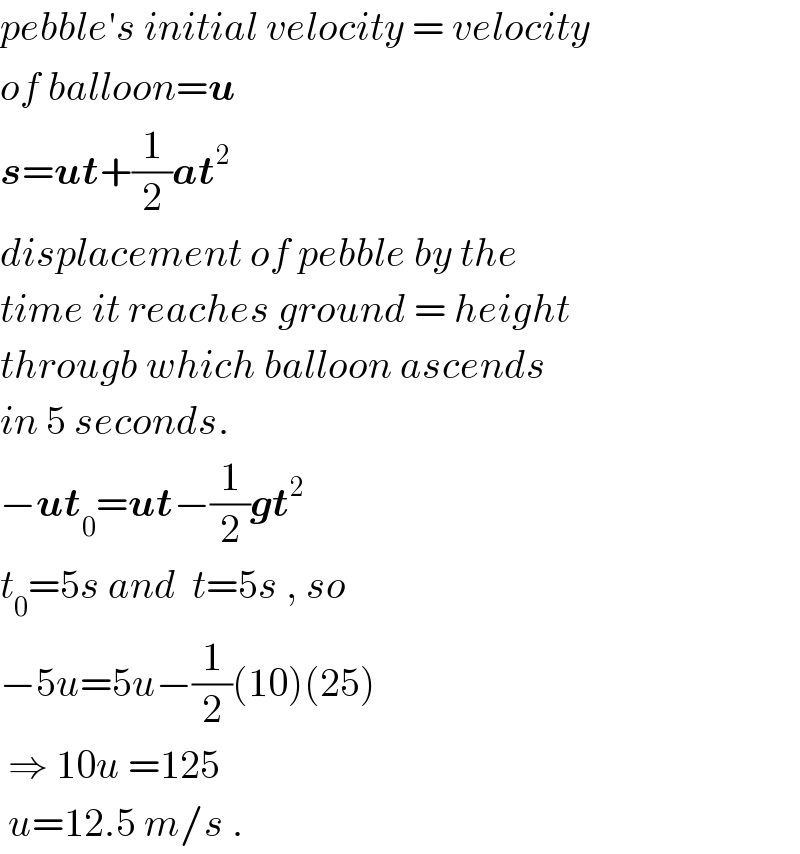
Question Number 15116 by Tinkutara last updated on 07/Jun/17

$$\mathrm{A}\:\mathrm{balloon}\:\mathrm{ascends}\:\mathrm{vertically}\:\mathrm{with}\:\mathrm{a} \\ $$$$\mathrm{constant}\:\mathrm{speed}\:\mathrm{for}\:\mathrm{5}\:\mathrm{seconds},\:\mathrm{when}\:\mathrm{a} \\ $$$$\mathrm{pebble}\:\mathrm{falls}\:\mathrm{from}\:\mathrm{it}\:\mathrm{reaching}\:\mathrm{the}\:\mathrm{ground} \\ $$$$\mathrm{in}\:\mathrm{5}\:\mathrm{s}.\:\mathrm{The}\:\mathrm{speed}\:\mathrm{of}\:\mathrm{the}\:\mathrm{balloon}\:\mathrm{is}? \\ $$
Answered by ajfour last updated on 07/Jun/17

$${pebble}'{s}\:{initial}\:{velocity}\:=\:{velocity} \\ $$$${of}\:{balloon}=\boldsymbol{{u}} \\ $$$$\boldsymbol{{s}}=\boldsymbol{{ut}}+\frac{\mathrm{1}}{\mathrm{2}}\boldsymbol{{at}}^{\mathrm{2}} \\ $$$${displacement}\:{of}\:{pebble}\:{by}\:{the} \\ $$$${time}\:{it}\:{reaches}\:{ground}\:=\:{height} \\ $$$${througb}\:{which}\:{balloon}\:{ascends} \\ $$$${in}\:\mathrm{5}\:{seconds}. \\ $$$$−\boldsymbol{{ut}}_{\mathrm{0}} =\boldsymbol{{ut}}−\frac{\mathrm{1}}{\mathrm{2}}\boldsymbol{{gt}}^{\mathrm{2}} \\ $$$${t}_{\mathrm{0}} =\mathrm{5}{s}\:{and}\:\:{t}=\mathrm{5}{s}\:,\:{so} \\ $$$$−\mathrm{5}{u}=\mathrm{5}{u}−\frac{\mathrm{1}}{\mathrm{2}}\left(\mathrm{10}\right)\left(\mathrm{25}\right) \\ $$$$\:\Rightarrow\:\mathrm{10}{u}\:=\mathrm{125} \\ $$$$\:{u}=\mathrm{12}.\mathrm{5}\:{m}/{s}\:. \\ $$
Commented by Tinkutara last updated on 07/Jun/17

$$\mathrm{Thanks}\:\mathrm{Sir}! \\ $$
Answered by mrW1 last updated on 07/Jun/17

$$\mathrm{v5}=−\mathrm{v5}+\frac{\mathrm{1}}{\mathrm{2}}×\mathrm{10}×\mathrm{5}^{\mathrm{2}} \\ $$$$\mathrm{v}=\mathrm{12}.\mathrm{5}\:\mathrm{m}/\mathrm{s} \\ $$
Commented by Tinkutara last updated on 07/Jun/17

$$\mathrm{Thanks}\:\mathrm{Sir}! \\ $$
